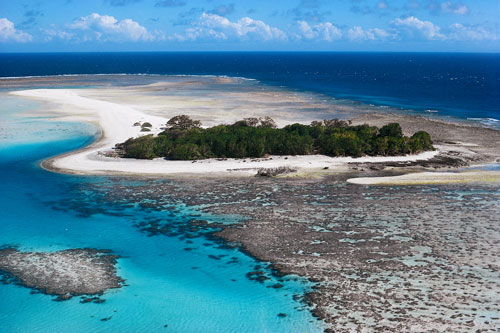Seabirds can predict El Nino
It took 18 years to study the number of birds living on the Great Barrier reef, scientists have discovered a predictable law of El Nino.
The powerful 'little boy' .
El Nino in Spanish means ' boy, baby '. This is a huge process of climate. El Nino warms the atmosphere and ocean, affecting the weather of the entire southern hemisphere.
During the unusual period of El Nino, due to differences in air pressure between Taiti Island and the Australian city of Darwin, hot air and hot currents from the western Pacific Ocean point east.

Great Barrier coral reef.(Photo: Corbis)
This movement is the cause of heavy showers and sea storms in the Western Pacific. The warm flow of El Nino changes the cold flow, making the flow in Humboldt (Peruvian waters) more ephemeral and fish.
As a result, the number of fish species in the Eastern Pacific is reduced. This fluctuation occurs every 2-7 years, which can last from 1 month to 4 years.
El Nino and seabirds
The effect of El Nino on our Earth's climate is clear. It is difficult to evaluate this phenomenon properly.
In the opinion of many scientists, the abnormality of El Nino affects the species that live in the ocean, and also seabirds. Therefore, it is necessary to find a standard object to accurately predict, but it is difficult.
Biologists, led by Dr. James Carol Devney of James Cook University and Dr. Carol Devney of James Cook University in Queensland, have found the law. They had 18 years of research on seabirds living in the tropical west of the Pacific Ocean.
Dr. Carol Devney has found the rule, repeated in a certain time. Within 10 months, before the El Nino phenomenon, the number of pairs of birds decreased significantly. In addition, they answered the question, why birds change their behavior before the El Nino phenomenon.

Predict El Nino
After analyzing climate and oceanographic data, scientists came to a conclusion:
In the 10 months before the El Nino event, there will be some changes in the ocean . First of all, the depth of thermodynamics increases more pronounced, with the temperature of the water being 20 o C. Oceanographers have used this as evidence to influence the distribution of biota populations. sea.
Indeed, according to Dr. Devney's observation, the decrease in thermodynamic depth followed a series of other events. Firstly, reducing chlorophyll, that means plant toxins die slowly. The latter is to reduce the amount of plankton, algae and ultimately reduce the number of fish.
The relationship with birds is even more evident because the number of bird pairs is significantly reduced. Between 6.5 thousand pairs formed an average of only 3,000 pairs per year.
This publication was explained by scientists when observing for a short time, before the bird's birth, the number of fish preyed on birds decreased. Under such conditions, birds are not paired but only focus on finding food.
Scientists believe that using a bird's-eye monitor and quantitative life monitor can help predict the phenomenon of El Nino.
- More than 8,000 unusually dead seabirds along Alaska's beaches
- Can predict the phenomenon of El Nino earlier
- Count seabirds by recording sounds
- 'Population' seabirds reduced the alarm
- El Nino 2015 looks strange with the peak of 1997
- El Nino changes may cause many storms to land
- Nature is angry, El Nino will be more intense
- Can 2015 El Nino cause more natural disasters?
- Thousands of seabirds died from the tsunami in the United States
- The origin of the term El nino
- Seabirds eat more plastic than eat fish
- Predict the hot sun record in 2014
 Is the magnetic North Pole shift dangerous to humanity?
Is the magnetic North Pole shift dangerous to humanity? Washington legalizes the recycling of human bodies into fertilizer
Washington legalizes the recycling of human bodies into fertilizer Lightning stone - the mysterious guest
Lightning stone - the mysterious guest Stunned by the mysterious sunset, strange appearance
Stunned by the mysterious sunset, strange appearance